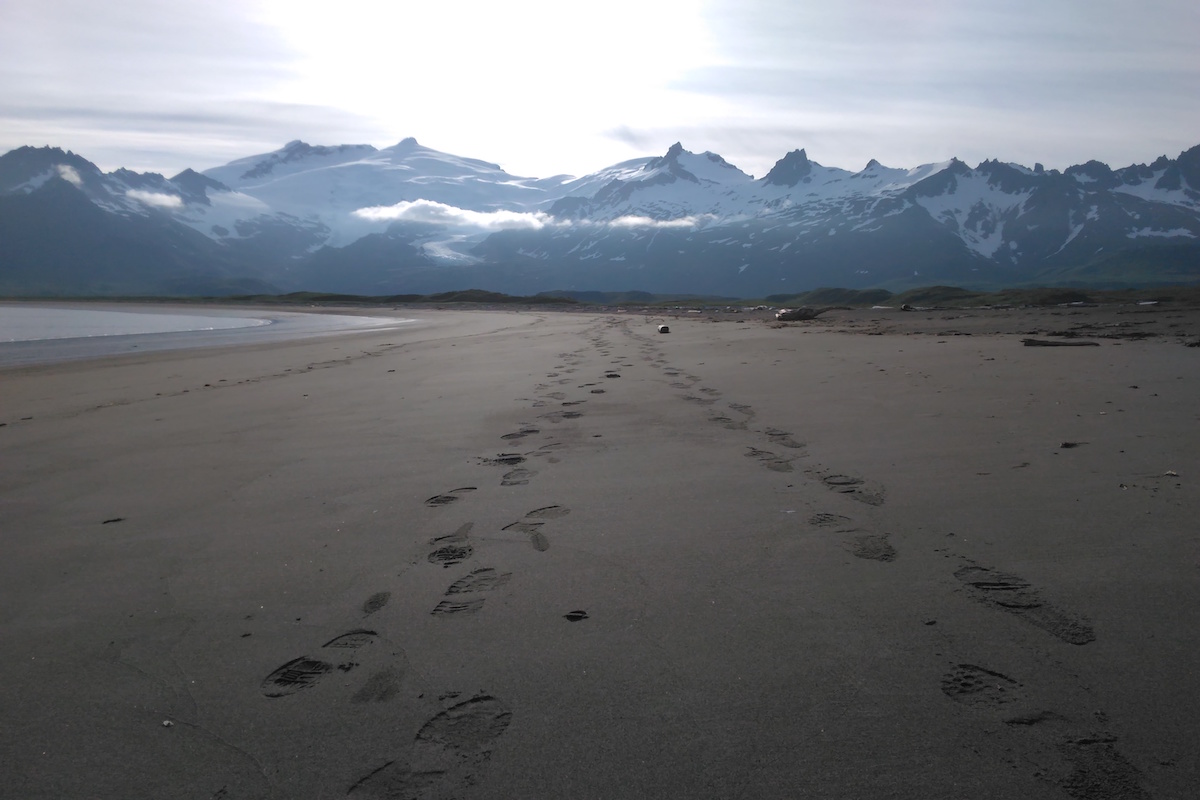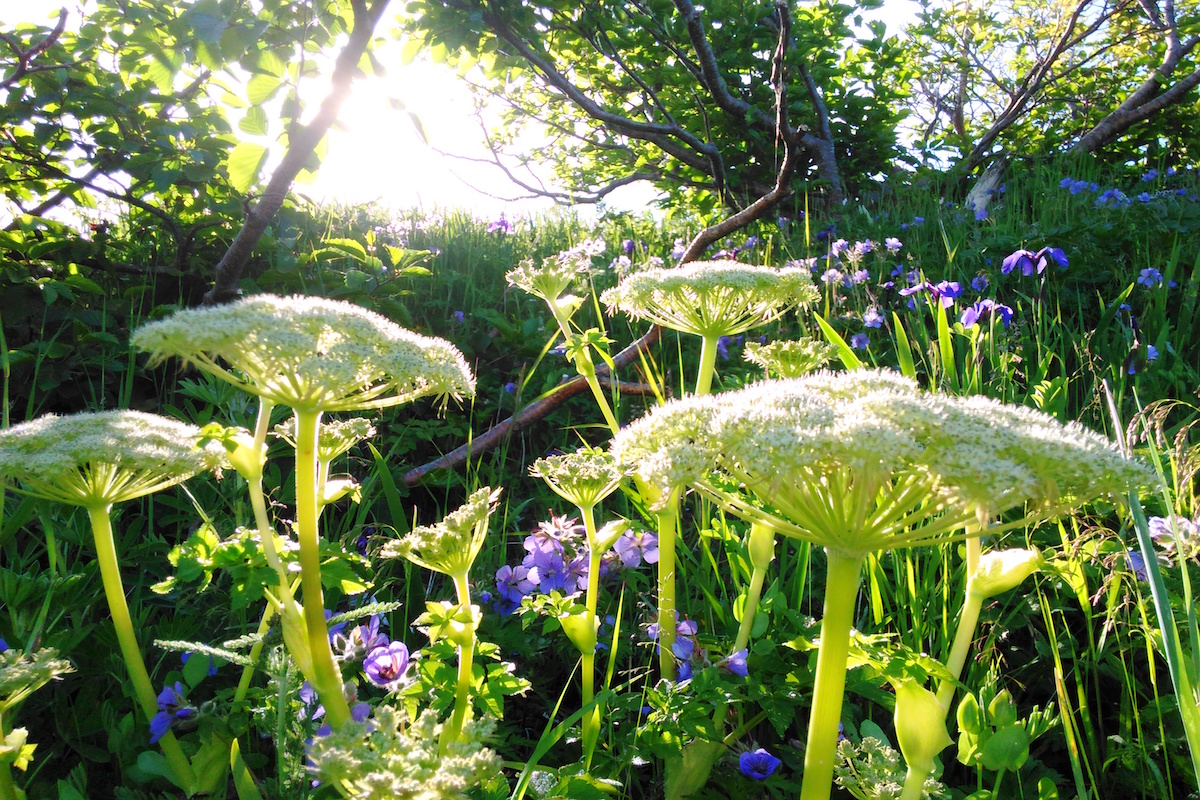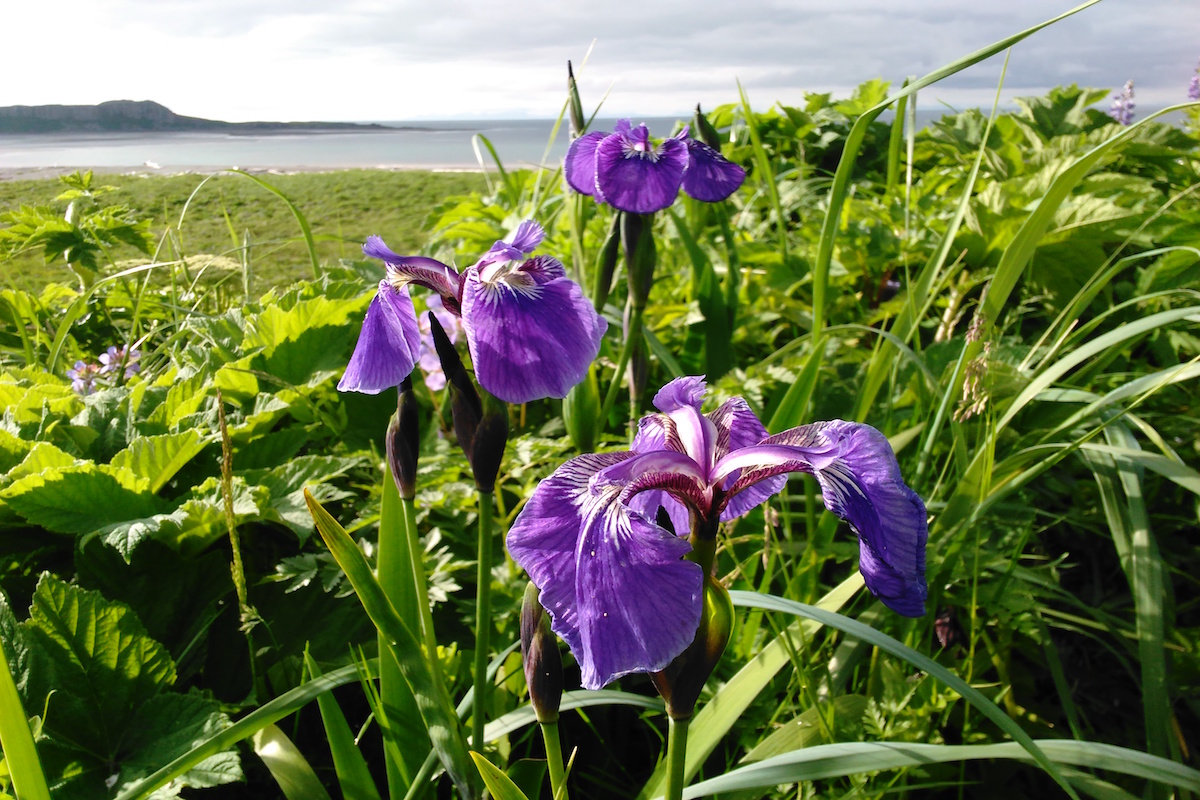 Bears along the coast dig up clams for sustenance, leaving behind shells. NPS Photo/C. Augustson.
Bears along the coast dig up clams for sustenance, leaving behind shells. NPS Photo/C. Augustson.
The waves crash and retreat slowly, forming a constant, rhythmic music on the Katmai coast. That these waters bring life is an old truism. Research bears out the remarkable gifts of the ocean time and time again. Along the wild coast of the park, bears and wolves alike are drawn to the shores by the abundant food that springs from the sea. The wet and mild climate fostered by the ocean also encourages the growth of lush sedge meadows, where bears graze on plant life before the overwhelming abundance of the salmon run.
Life here thrives, but it is precarious.
I witness a mother with her young spring cub moving along the edges of the cliffs along the isthmus of the Cape. The day is sky-blue and the moment is breathtaking in its loveliness. The mother lies on the green grass, seemingly free of worry, and the small, dark cub playfully leaps on her. The massive mother bear waves her paws towards the sky, lazily, as though she were mock surrendering to her vulnerable young.

Even seen at a distance, it is a remarkable site. It is easy to see the scene as bucolic and carefree, an explosion of pure life. But as bear researcher Joy Erlenbach notes, danger is ever present. She tells me that the mother likely used those cliffs as a vantage point to watch for danger, often in the form of larger males. Within view, larger males (the boars) are grazing below. One of those could easily kill that small cub. And so, even as they play, the mother must be ever watchful for the safety of her cub.
These moments are thrown in to high relief unexpectedly just minutes later as we walk along the beach, scouting the area for good viewing locations. Further down, lying in the sand, is a dying sea otter. We think it is already gone as we approach, but we see its chest moving slowly, laboriously, as we draw closer.
 Footprints mark the sandy beaches at Cape Douglas. Mount Douglas rises in the background. NPS Photo/C. Augustson.
Footprints mark the sandy beaches at Cape Douglas. Mount Douglas rises in the background. NPS Photo/C. Augustson.
“Come on now. Can you move at all?” Joy asks with a small tinge of hope. I look at its whiskers, it’s closed eyes, and its small frame. It is fading fast, and there is little we can do for it. “At least it is passing peacefully,” Joy finally says, when it is clear this animal is more than just ill.
I am quiet as we walk further down the beach. It is the first otter I have seen on the coast. I love otters, with their lithe movements in water, their seemingly cheery lives of bounding along shores and floating above the waves. To see one at the end of its life, passing within moments of witnessing the play of mother and cub, is strangely haunting. There is poignancy in the juxtaposition, and I struggle to express the range of emotions the situation suggests.
There is no ceremony for the sea otter. Hours later, we see ravens and gulls circling around its location. Not long after, a bear picks up the body and moves it some distance. He eats his fill and moves on. When we later explore the site the otter is barely recognizable, the remnants of a meal. I am quiet here as well, trying to find some understanding in what is ultimately a common occurrence.
 Sunlight filters through alder trees and flowering cow parsnip on the coast. Also known as pushkin, cow parsnip is photo toxic, which means it secretes an oil that reacts to sunlight as a defense mechanism, causing burns on exposed skin. NPS Photo/C. Augustson.
Sunlight filters through alder trees and flowering cow parsnip on the coast. Also known as pushkin, cow parsnip is photo toxic, which means it secretes an oil that reacts to sunlight as a defense mechanism, causing burns on exposed skin. NPS Photo/C. Augustson.
The bear does not return, but the next day, in the sunlight of an Alaska evening, a grey wolf picks up what remains and trots along the coast to the south, to share the bounty with its pack.
It is rare that we have the opportunity to see such stories play out. I consider myself tremendously fortunate to see life flow in so many varied and wild forms. I am tempted to ascribe some sort of lesson to the quiet drama that had unfolded over time. I want to say that in death the otter provided life, feeding a multitude of animals after its lonely end. I want to say that the scene of the bear feeding on the otter connects back nicely to the mother and her cub, to say that life recycles itself, that it finds a way in the middle of adversity. I could also just as easily line up the scenes as a reminder that even amidst the liveliest scenes of nature, the low dirge of death is always sounding.
We are pattern recognizing and storytelling by nature, and we can forge any number of meanings to a collection of events that we find to be in some way palpable or unnerving. For me, these moments seemed too striking to let pass without comment. There was something deeply moving about the otter’s last quiet moments on the beach, heightened by a scene so joyous just moments before. That image stayed with me, long after bird and bear and wolf took what later remained. I do not know what ended the otter’s life: whether illness or age or unseen injury. I do not know what it’s earlier days resembled, whether it swam far and wide, whether it was a parent and mate, whether it was a fierce hunter or a poor one. But as we walked along the beach, I knew almost immediately that I wanted to write something by which this animal could be remembered. I could not help it, but I did not want this one small mammal to pass unremembered on Katmai’s wild shores.
 Wild Irises bloom at Cape Douglas during a brief growing season. NPS Photo/C. Augustson.
Wild Irises bloom at Cape Douglas during a brief growing season. NPS Photo/C. Augustson.
Meanwhile the waves wash over the sands, and the music of water mingles with the plaintive cries of gulls. Along the shores, a million episodes like these happen each and every day with no human eyes to see them, no human mind to reckon with them. The waves never cease.
